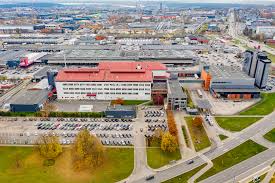
Ongoing Commitment to Reducing Waste
For several years, we’ve been committed to minimizing waste across our operations. We are intensifying our focus on reducing food waste by participating in and launching initiatives aimed at prevention.
Key Achievements
For several years, we’ve been committed to minimizing waste across our operations. We are intensifying our focus on reducing food waste by participating in and launching initiatives aimed at prevention.
Key Achievements
- ~30% reduction in food waste at our manufacturing facilities (compared to 2018)¹
- ~47% reduction in food waste during distribution (compared to 2018)²
Strategic Focus
With nearly one-third of all food produced globally going uneaten, we recognize the urgent need to act. Our strategy centers on minimizing food waste at our company-owned manufacturing sites by targeting high-impact areas.
At Mondelēz International, robust governance systems guide us in pinpointing where the most significant food losses occur during production. These insights allow us to enhance processes and continuously improve how we manage and reduce waste.
We use Lean Six Sigma methodologies and cutting-edge digital and engineering tools to build more efficient systems. Through constant performance monitoring, we are able to quickly respond and implement necessary changes. Our teams regularly evaluate operations to identify waste reduction opportunities and adjust accordingly.
Actions and Outcomes
Last year, our sustainability efforts were concentrated on boosting the efficiency of our production lines. Monthly tracking of waste trends enabled us to uncover high-impact opportunities for improvement across various regions and processes.
We’ve set a target to reduce food waste in our internal manufacturing by around 15% by 2025 (using 2018 as the benchmark), while each business unit and facility pursues its own specific objectives. Our focus extends beyond food waste to include overall waste generation, treatment, and diversion from landfills.
In 2024, our approach paid off—food waste from internal manufacturing was cut by about 30%, significantly ahead of our 2025 target. We also reduced food waste from distribution by roughly 47%, keeping us on track to meet our goals.
Some standout examples include:
With nearly one-third of all food produced globally going uneaten, we recognize the urgent need to act. Our strategy centers on minimizing food waste at our company-owned manufacturing sites by targeting high-impact areas.
At Mondelēz International, robust governance systems guide us in pinpointing where the most significant food losses occur during production. These insights allow us to enhance processes and continuously improve how we manage and reduce waste.
We use Lean Six Sigma methodologies and cutting-edge digital and engineering tools to build more efficient systems. Through constant performance monitoring, we are able to quickly respond and implement necessary changes. Our teams regularly evaluate operations to identify waste reduction opportunities and adjust accordingly.
Actions and Outcomes
Last year, our sustainability efforts were concentrated on boosting the efficiency of our production lines. Monthly tracking of waste trends enabled us to uncover high-impact opportunities for improvement across various regions and processes.
We’ve set a target to reduce food waste in our internal manufacturing by around 15% by 2025 (using 2018 as the benchmark), while each business unit and facility pursues its own specific objectives. Our focus extends beyond food waste to include overall waste generation, treatment, and diversion from landfills.
In 2024, our approach paid off—food waste from internal manufacturing was cut by about 30%, significantly ahead of our 2025 target. We also reduced food waste from distribution by roughly 47%, keeping us on track to meet our goals.
Some standout examples include:
- Claremont, Australia: This site significantly improved its waste performance through feedstock optimization, better segregation, rework tagging, automation, and digital waste tracking. These changes led to a reduction of over 1,100 tonnes of food waste—a 46% improvement year-over-year.
- Vitória de Santo Antão, Brazil: Efficiency initiatives here led to a reduction of more than 440 metric tonnes of food waste, thanks to a series of process enhancements.
- Curitiba, Brazil: The plant introduced a circular economy project where high-sugar waste is repurposed by third parties for ethanol production. This initiative prevents around 840 metric tonnes of waste annually.
Preventing Edible Food from Going to Waste
In 2024, our Philadelphia brand deepened its collaboration with the Too Good To Go app. This effort helped consumers in countries such as Austria, Germany, and Sweden purchase items nearing expiration. We also addressed confusion around best-before dates by including the “Often Good After” label on our packaging.
In Sweden, we supported Matmissionen supermarkets by donating surplus products, which are sold at discounted prices to individuals facing economic hardship.
Looking Ahead
We are steadily advancing toward our goal of eliminating food waste by strengthening our prevention and reduction programs in partnership with key stakeholders.
Targets
In 2024, our Philadelphia brand deepened its collaboration with the Too Good To Go app. This effort helped consumers in countries such as Austria, Germany, and Sweden purchase items nearing expiration. We also addressed confusion around best-before dates by including the “Often Good After” label on our packaging.
In Sweden, we supported Matmissionen supermarkets by donating surplus products, which are sold at discounted prices to individuals facing economic hardship.
Looking Ahead
We are steadily advancing toward our goal of eliminating food waste by strengthening our prevention and reduction programs in partnership with key stakeholders.
Targets
- 15% reduction in food waste from internal manufacturing by 2025 (vs. 2018)
- 50% reduction in food waste from distribution by 2025 (vs. 2018)
2024 Performance Snapshot
| Metric | 2024 | 2023 | 2018 |
|---|---|---|---|
| Total waste from manufacturing (metric tons) | 319,000 | 332,000 | 383,000 |
| Total food waste from manufacturing (metric tons) | 196,000 | 207,000 | 278,000 |
| Food waste reduction (manufacturing, vs. 2018) | 30% | 26% | - |
| Food waste reduction (distribution, vs. 2018) | 47% | 69% | - |


 Mondelez Cuts Food Waste by 30% with Sustainable Manufacturing
Mondelez Cuts Food Waste by 30% with Sustainable Manufacturing




 Companies
Companies